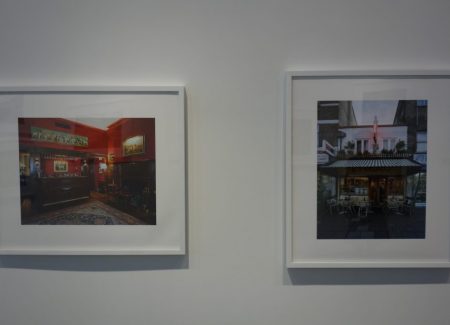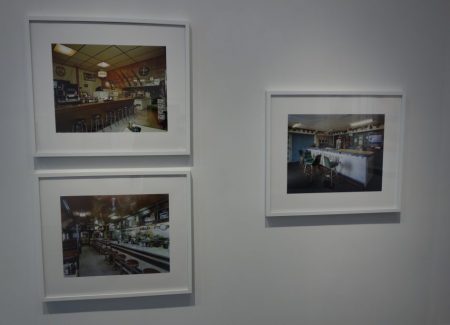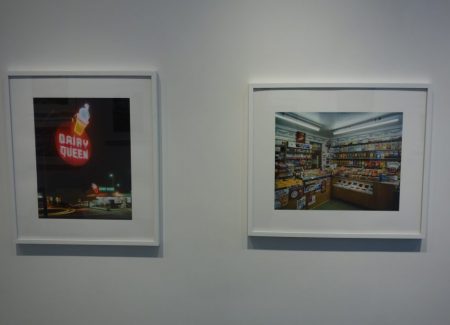JTF (just the facts): A total of 20 color photographs, framed in white and unmatted, and hung against white walls in the single room gallery space. All of the works are pigment prints, made between 1978 and 2017. Physical sizes are either 16×20 (in editions of 25) or 30×40 (in editions of 10). There are 18 small prints and 2 large prints on display. (Installation shots below.)
Comments/Context: Decades come and go, as do photographic styles, but straightforward images of vernacular architecture never seem to lose their ability to draw us in. Whether the pictures show us busy urban storefronts, homey rural diners, hand painted signage, or the soft glow of neon, they remind us of the everyday fabric of our own lives. And when they are seen across a wider arc of history, they show us just how much our functional, domestic routines have been changing. Regardless of the city or country they might depict, pictures like these capture for posterity the visual quirks and recognizable details of local culture, bottling the uniqueness of regional specialties and commercial innovation.
Without much effort, we can recall plenty of master photographers who have turned their cameras to such subjects. Eugène Atget showed us the storefronts and street vendors of early 1900s Paris, Berenice Abbott brought us closer to the sidewalks of 1930s New York, Walker Evans steeped us in the elemental wooden lines and painted advertisements of small town America, and William Christenberry took the long view of local barns and warehouses in the rural South.
This particular vernacular show picks up that common line of photographic thinking, taking a thematic cross section of Jim Dow’s five decade photographic career and pulling out notable images of bars and restaurants, largely in America but also in far flung locales from Mexico to the United Kingdom. His crisp pictures (consistently made from large format 8×10 negatives) bring us into intimate dialogue with humble taco trucks, coffee trailers, neighborhood fish & chips joints, butcher shops, candy stores, and even a snow cone hut, each a uniquely stylized manifestation of what the locals (and the proprietors) want.
Dow’s photographs are really like portraits of places, where the shopkeepers and customers have been swept away, leaving behind the visual communication of the physical space. Even when these eateries and watering holes are populated with eccentric decorating touches, Dow never treats them with anything but full respect. Doug’s Bar uses shotguns and rifles as décor, with cases of beer stacked and ready nearby (what could be better than the combination of guns and booze?) At the Old School Bar & BBQ, vintage 45s are nailed in a stripe near the ceiling, and the bar at the quietly posh Leash Club is surrounded by painted portraits of regal hounds. Farther afield, the ceiling of the dining room at the Restaurant El Arroyo (in Mexico) is draped with colorful cut paper decorations, while Southward’s Sweet Shop in the UK offers a hopelessly dense display of attractive candies.
When night falls, Dow’s eye for the nuances of color gets even better. A flash lit coffee cart in Uruguay feels perkily inviting in its cotton candy pastel pink paint, while a taco truck in east LA uses a strip of green neon to draw customers in. At other establishments, pastel blue balances with fire engine red, and humming white blares from the windows. And the neon Dairy Queen sign in North Carolina sits amid the blackness of the sky like a red planet, the soft-serve cone in the logo like a rocket ship blasting into space.
What makes these pictures so engrossing is their deep sense of place – we can immediately understand that these bars and restaurants occupy a particular spot in the lives of the locals, and that their quirky details give them the character that brings people back. The red leather stools at the Four Aces Diner in New Hampshire and the blue and white checkerboard tile at the Colonia de Caroyua butcher shop in Argentina feel like landmarks, and Dow’s well-made photographs celebrate these details with patient curiosity and understated reverence.
Collector’s POV: The prints in this show are priced at either $3000 (16×20) or $5500 (30×40), with one image (the Coca-Cola button) sold out in the smaller size. Dow’s work has only been intermittently available in the secondary markets in recent years, with prices for the few lots that have sold ranging from roughly $1500 to $3500.











